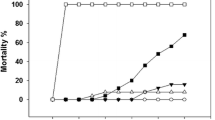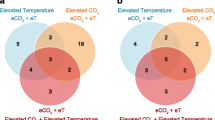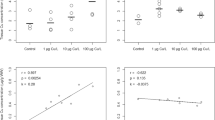Abstract
Freshwater mussels are some of the most imperiled species in North America and are particularly susceptible to environmental change. One environmental disturbance that mussels may encounter that remains understudied is an increase in the partial pressure of CO2 (pCO2). The present study quantified the impacts of acute (6 h) and chronic (up to 32 days) exposures to elevated pCO2 on genes associated with shell formation (chitin synthase; cs) and the stress response (heat shock protein 70; hsp70) in Fusconaia flava. Oxygen consumption (MO2) was also assessed over the chronic CO2 exposure period. Although mussels exhibited an increase in cs following an acute exposure to elevated pCO2, long-term exposure resulted in a decrease in cs mRNA abundance, suggesting that mussels may invest less in shell formation during chronic exposure to elevated pCO2. In response to an acute elevation in pCO2, mussels increased hsp70 mRNA abundance in mantle and adductor muscle and a similar increase was observed in the gill and adductor muscle in response to a chronic elevation in pCO2. A chronic elevation in pCO2 also increased mussel MO2. This overall increase in hsp70 mRNA levels and MO2 in F. flava indicates that exposure to elevated pCO2 initiates activation of the general stress response and an increased energy demand. Together, the results of the present study suggest that freshwater mussels respond to elevated pCO2 by increasing processes necessary to ‘deal with’ the stressor and, over the long-term, may reduce their investment in non-essential processes such as shell growth.





Similar content being viewed by others
References
Anscombe FJ, Tukey JW (1963) The examination and analysis of residuals. Technometrics 5:141–160
Bates DM (2010) lme4: mixed-effects modeling with R
Beniash E, Ivanina A, Lieb NS, Kurochkin I, Sokolova IM (2010) Elevated level of carbon dioxide affects metabolism and shell formation in oysters Crassostrea virginica (Gmelin). Mar Ecol Prog Ser 419:95–108. doi:10.3354/meps08841
Bogan AE (2008) Global diversity of freshwater mussels (Mollusca, Bivalvia) in freshwater. Hydrobiologia 595:139–147. doi:10.1007/s10750-007-9011-7
Butman D, Raymond PA (2011) Significant efflux of carbon dioxide from streams and rivers in the United States. Nat Geosci 4:839–842. doi:10.1038/ngeo1294
Cellura C, Toubiana M, Parrinello N, Roch P (2006) HSP70 gene expression in Mytilus galloprovincialis hemocytes is triggered by moderate heat shock and Vibrio anguillarum, but not by V. splendidus or Micrococcus lysodeikticus. Dev Comp Immunol 30:984–997. doi:10.1016/j.dci.2005.12.009
Chen H, Zha J, Liang X, Li J, Wang Z (2014) Effects of the human antiepileptic drug carbamazepine on the behavior, biomarkers, and heat shock proteins in the Asian clam Corbicula fluminea. Aquat Toxicol 155:1–8. doi:10.1016/j.aquatox.2014.06.001
Cole JJ, Caraco NF (2001) Carbon in catchments: connecting terrestrial carbon losses with aquatic metabolism. Mar Freshw Res 52:101–110
Cole JJ, Caraco NF, Kling GW, Kratz TK (1994) Carbon dioxide supersaturation in the surface waters of lakes. Science 265:1568–1570
Cole JJ, Prairie YT, Caraco NF, McDowell WH, Tranvik LJ, Striegl RG, Duarte CM, Kortelainen P, Downing JA, Middelburg JJ, Melack J (2007) Plumbing the global carbon cycle: integrating inland waters into the terrestrial carbon budget. Ecosystems 10:172–185. doi:10.1007/s10021-006-9013-8
Conover WJ, Iman RL (1981) Rank transformations as a bridge between parametric and nonparametric statistics. Am Stat 35:124–129
Crenshaw MA (1972) The inorganic composition of molluscan extrapallial fluid. Biol Bull 143:506–512
Cummings V, Hewitt J, Van Rooyen A, Currie K, Beard S, Thrush S, Norkko J, Barr N, Heath P, Halliday NJ, Sedcole R, Gomez A, McGraw C, Metcalf V (2011) Ocean acidification at high latitudes: potential effects on functioning of the Antarctic bivalve Laternula elliptica. PLoS One 6:e16069. doi:10.1371/journal.pone.0016069
Fabbri E, Valbonesi P, Frazellitti S (2008) HSP expression in bivalves. Invert Surviv J 5:135–161
Fabry VJ, Seibel BA, Feely RA, Orr JC (2008) Impacts of ocean acidification on marine fauna and ecosystem processes. ICES Int Counc Explor Sea Mar Sci Symp 65:414–432
Fang D, Xu G, Hu Y, Pan C, Xie L, Zhang R (2011) Identification of genes directly involved in shell formation and their functions in pearl oyster, Pinctada fucata. PLoS One 6:e21860. doi:10.1371/journal.pone.0021860
Feder ME, Hofmann GE (1999) Heat-shock proteins, molecular chaperones, and the stress response: evolutionary and ecological physiology. Annu Rev Physiol 61:243–282
Fernández-Reiriz MJ, Range P, Álvarez-Salgado XA, Labarta U (2011) Physiological energetics of juvenile clams Ruditapes decussatus in a high CO2 coastal ocean. Mar Ecol Prog Ser 433:97–105. doi:10.3354/meps09062
Franzellitti S, Fabbri E (2005) Differential HSP70 gene expression in the Mediterranean mussel exposed to various stressors. Biochem Biophys Res Commun 336:1157–1163. doi:10.1016/j.bbrc.2005.08.244
Fritts AK, Peterson JT, Wisniewski JM, Bringolf RB (2015) Evaluation of methods for assessing physiological biomarkers of stress in freshwater mussels. Can J Fish Aquat Sci 72:1450–1459. doi:10.1139/cjfas-2014-0565
Gazeau F, Parker LM, Comeau S, Gattuso J-P, O’Connor WA, Martin S, Pörtner H-O, Ross PM (2013) Impacts of ocean acidification on marine shelled molluscs. Mar Biol 160:2207–2245. doi:10.1007/s00227-013-2219-3
Hannan KD, Jeffrey JD, Hasler CT, Suski CD (2016) Physiological effects of short and long-term hypercarbia on a freshwater mussel, Fusconaia flava. Can J Fish Aquat Sci
Hasler CT, Butman D, Jeffrey JD, Suski CD (2016) Freshwater biota and rising pCO2? Ecol Lett 19:98–108. doi:10.1111/ele.12549
Hauer FR, Lamberti GA (2007) Methods in stream ecology, vol 2. Academic Press, Amsterdam
Iman RL, Hors SC, Conover WJ (1984) Comparison of asymptotically distribution-free procedures for the analysis of complete blocks. J Am Stat Assoc 79:674–685
Ivanina AV, Hawkins C, Sokolova IM (2014) Immunomodulation by the interactive effects of cadmium and hypercapnia in marine bivalves Crassostrea virginica and Mercenaria mercenaria. Fish Shellfish Immunol 37:299–312. doi:10.1016/j.fsi.2014.02.016
Jeffrey JD, Hasler CT, Chapman JM, Cooke SJ, Suski CD (2015) Linking landscape-scale disturbances to stress and condition of fish: implications for restoration and conservation. Integr Comp Biol 55:618–630. doi:10.1093/icb/icv022
Kates D, Dennis C, Noatch MR, Suski CD, MacLatchy DL (2012) Responses of native and invasive fishes to carbon dioxide: potential for a nonphysical barrier to fish dispersal. Can J Fish Aquat Sci 69:1748–1759. doi:10.1139/f2012-102
Laird NM, Ware JH (1982) Random-effects models for longitudinal data. Biometrics 38:963–974
Lannig G, Eilers S, Portner HO, Sokolova IM, Bock C (2010) Impact of ocean acidification on energy metabolism of oyster, Crassostrea gigas—changes in metabolic pathways and thermal response. Mar Drugs 8:2318–2339. doi:10.3390/md8082318
Levi-Kalisman Y, Falini G, Addadi L, Weiner S (2001) Structure of the nacreous organic matrix of a bivalve mollusk shell examined in the hydrated state using cryo-TEM. J Struct Biol 135:8–17. doi:10.1006/jsbi.2001.4372
Lindstrom MJ, Bates DM (1990) Nonlinear mixed effects models for repeated measures data. Biometrics 46:673–687
Liu W, He M (2012) Effects of ocean acidification on the metabolic rates of three species of bivalve from southern coast of China. Chin J Oceanol Limnol 30:206–211. doi:10.1007/s00343-012-1067-1
Luo Y, Li C, Landis AG, Wang G, Stoeckel J, Peatman E (2014) Transcriptomic profiling of differential responses to drought in two freshwater mussel species, the giant floater Pyganodon grandis and the pondhorn Uniomerus tetralasmus. PLoS One 9:e89481. doi:10.1371/journal.pone.0089481
Lydeard C, Cowie RH, Ponder WF, Bogan AE, Bouchet P, Clark SA, Cummings KS, Frest TJ, Gargominy O, Herbert DG, Hershler R, Perez KE, Roth B, Seddon M, Strong EE, Thompson FG (2004) The global decline of nonmarine mollusks. Bioscience 54:321–330
Maberly SC (1996) Diel, episodic and seasonal changes in pH and concentrations of inorganic carbon in a productive lake. Freshw Biol 35:579–598
Matoo OB, Ivanina AV, Ullstad C, Beniash E, Sokolova IM (2013) Interactive effects of elevated temperature and CO2 levels on metabolism and oxidative stress in two common marine bivalves (Crassostrea virginica and Mercenaria mercenaria). Comp Biochem Physiol A Mol Integr Physiol 164:545–553. doi:10.1016/j.cbpa.2012.12.025
Menge BA, Daley BA, Sanford E, Dahlhoff EP, Lubchenco J (2007) Mussel zonation in New Zealand: an integrative eco-physiological approach. Mar Ecol Prog Ser 345:129–141. doi:10.3354/meps06951
Michaelidis B, Ouzounis C, Paleras A, Pörtner HO (2005) Effects of long-term moderate hypercapnia on acid-base balance and growth rate in marine mussels Mytilus galloprovincialis. Mar Ecol Prog Ser 293:109–118
Millero FJ (1979) The thermodynamics of the carbonate system in seawater. Geochimica et Cosmochimica Acta 43(10):1651–1661
Moran D (2014) The importance of accurate CO2 dosing and measurement in ocean acidification studies. J Exp Biol 217:1827–1828. doi:10.1242/jeb.104414
Navarro JM, Torres R, Acuna K, Duarte C, Manriquez PH, Lardies M, Lagos NA, Vargas C, Aguilera V (2013) Impact of medium-term exposure to elevated pCO2 levels on the physiological energetics of the mussel Mytilus chilensis. Chemosphere 90:1242–1248. doi:10.1016/j.chemosphere.2012.09.063
Noatch MR, Suski CD (2012) Non-physical barriers to deter fish movements. Environ Rev 20:71–82. doi:10.1139/a2012-001
Norkko J, Thrush SF, Wells RMG (2006) Indicators of short-term growth in bivalves: detecting environmental change across ecological scales. J Exp Mar Biol Ecol 337:38–48. doi:10.1016/j.jembe.2006.06.003
Parker LM, Ross PM, O’Connor WA, Borysko L, Raftos DA, Pörtner H-O (2012) Adult exposure influences offspring response to ocean acidification in oysters. Glob Change Biol 18:82–92. doi:10.1111/j.1365-2486.2011.02520.x
Perga M-E, Maberly SC, Jenny J-P, Alric B, Pignol C, Naffrechoux E (2016) A century of human-driven changes in the carbon dioxide concentration of lakes. Glob Biogeochem Cycles 30:93–104. doi:10.1002/2015GB005286
Pfaffl MW (2001) A new mathematical model for relative quantification in real-time RT-PCR. Nucleic Acids Res 29:e45
Phillips J, McKinley G, Bennington V, Bootsma H, Pilcher D, Sterner R, Urban N (2015) The potential for CO2-induced acidification in freshwater: a great lakes case study. Oceanography 25:136–145. doi:10.5670/oceanog.2015.37
Piano A, Valbonesi P, Fabbri E (2004) Expression of cytoprotective proteins, heat shock protein 70 and metallothioneins, in tissues of Ostrea edulis exposed to heat and heavy metals. Cell Stress Chaperones 9:134. doi:10.1379/483.1
Pörtner H (2008) Ecosystem effects of ocean acidification in times of ocean warming: a physiologist’s view. Mar Ecol Prog Ser 373:203–217. doi:10.3354/meps07768
Pörtner HO, Langenbuch M, Reipschläger A (2004) Biological impact of elevated ocean CO2 concentrations: lessons from animal physiology and earth history. J Oceanogr 60:705–718
Potvin C, Roff DA (1995) Distribution-free and robust statistical methods viable alternatives to parametric statistics. Ecology 76:2000
Regnier C, Fontaine B, Bouchet P (2009) Not knowing, not recording, not listing: numerous unnoticed mollusk extinctions. Conserv Biol 23:1214–1221. doi:10.1111/j.1523-1739.2009.01245.x
Riebesell U, Fabry VJ, Hansson L, Gattuso J-P (2010) Guide to best practices for ocean acidification research and data reporting. Publications Office of the European Union, Luxembourg
Robbins LL, Hansen ME, Kleypas JA, Meylan SC (2010) CO2calc: A user-friendly seawater carbon calculator for Windows, Mac OS X, and iOS (iPhone). US Geological Survey, Reston
Schonitzer V, Weiss IM (2007) The structure of mollusc larval shells formed in the presence of the chitin synthase inhibitor Nikkomycin Z. BMC Struct Biol 7:71. doi:10.1186/1472-6807-7-71
Sørensen JG, Kristensen TN, Loeschcke V (2003) The evolutionary and ecological role of heat shock proteins. Ecol Lett 6:1025–1037. doi:10.1046/j.1461-0248.2003.00528.x
Steffensen JF (1989) Some errors in respirometry of aquatic breathers: how to avoid and correct for them. Fish Physiol Biochem 6:49–59
Strayer DL, Downing JA, Haag WR, King TL, Layzer JB, Newton TJ, Nichols SJ (2004) Changing perspectives on pearly mussels, North America’s most imperiled animals. Bioscience 54:429–439
Thomsen J, Melzner F (2010) Moderate seawater acidification does not elicit long-term metabolic depression in the blue mussel Mytilus edulis. Mar Biol 157:2667–2676. doi:10.1007/s00227-010-1527-0
Toyohara H, Hosoi M, Hayashi I, Kibota S, Hashimoto H, Yokoyama Y (2005) Expression of HSP70 in response to heat-shock and its cDNA cloning from Mediterranean blue mussel. Fish Sci 71:327–332
Tsangaris C, Kormas K, Strogyloudi E, Hatzianestis I, Neofitou C, Andral B, Galgani F (2010) Multiple biomarkers of pollution effects in caged mussels on the Greek coastline. Comp Biochem Physiol C Comp Pharmacol 151:369–378. doi:10.1016/j.cbpc.2009.12.009
Vaughn CC (2010) Biodiversity losses and ecosystem function in freshwaters: emerging conclusions and research directions. Bioscience 60:25–35. doi:10.1525/bio.2010.60.1.7
Vaughn CC, Hakenkamp CC (2001) The functional role of burrowing bivalves in freshwater ecosystems. Freshw Biol 46:1431–1446
Weiner W, Traub W, Parker SB (1984) Macromolecules in mollusc shells and their functions in biomineralization. Philos Trans R Soc Lond B Biol Sci 304:425–434
Weiss IM, Schonitzer V (2006) The distribution of chitin in larval shells of the bivalve mollusk Mytilus galloprovincialis. J Struct Biol 153:264–277. doi:10.1016/j.jsb.2005.11.006
Weiss IM, Schonitzer V, Eichner N, Sumper M (2006) The chitin synthase involved in marine bivalve mollusk shell formation contains a myosin domain. FEBS Lett 580:1846–1852. doi:10.1016/j.febslet.2006.02.044
Wicks LC, Roberts JM (2012) Benthic invertebrates in a high-CO2 world. In: Gibson RN, Atkinson RJA, Gordon JDM, Hughes RN, Hughes DJ, Smith IP (eds) Oceanography and marine biology: an annual review, vol 50. CRC Press, Boca Raton, pp 127–187
Widdows J, Donkin P, Staff RJ, Matthiessen P, Law RJ, Allen YT, Thain JE, Allchin CR, Jones BR (2002) Measurements of stress effects (scope for growth) and contaminant levels in mussels (Mytilus edulis) collected in the Irish sea. Mar Environ Res 53:327–356
Wilbur KM, Saleuddin ASM (1983) Shell formation. In: Saleuddin ASM, Wilbur KM (eds) The mollusca, vol 4. Academic Press, New York, pp 235–287
Williams JD, Warren ML, Cummings KS, Harris JL, Neves RJ (1993) Conservation status of freshwater mussels of the United States and Canada. Endanger Species 18:6–22
Yost HJ, Petersen RB, Lindquist S (1990) RNA metabolism: strategies for regulation in the heat shock response. Trends Genet 6:223–227
Acknowledgments
This work was supported by the Illinois Department of Natural Resources, and the United States Geological Survey, through funds provided by the United States Environmental Protection Agency’s Great Lakes Restoration Initiative. Funding was also provided by USFWS Federal Aid in Sport Fish Restoration Project F-69-R, and the USDA National Institute of Food and Agriculture Hatch project ILLU-875-947. J. Tiemann, K. Cummings, J. Tix, C. Sullivan, and J. Sherwood provided valuable help collecting mussels. We would also like to thanks A. Wright for providing valuable help with mussel husbandry and laboratory assistance, as well as S. Adhikari for her assistance with molecular techniques.
Author information
Authors and Affiliations
Corresponding author
Additional information
Communicated by H.V. Carey.
Rights and permissions
About this article
Cite this article
Jeffrey, J.D., Hannan, K.D., Hasler, C.T. et al. Responses to elevated CO2 exposure in a freshwater mussel, Fusconaia flava . J Comp Physiol B 187, 87–101 (2017). https://doi.org/10.1007/s00360-016-1023-z
Received:
Revised:
Accepted:
Published:
Issue Date:
DOI: https://doi.org/10.1007/s00360-016-1023-z




